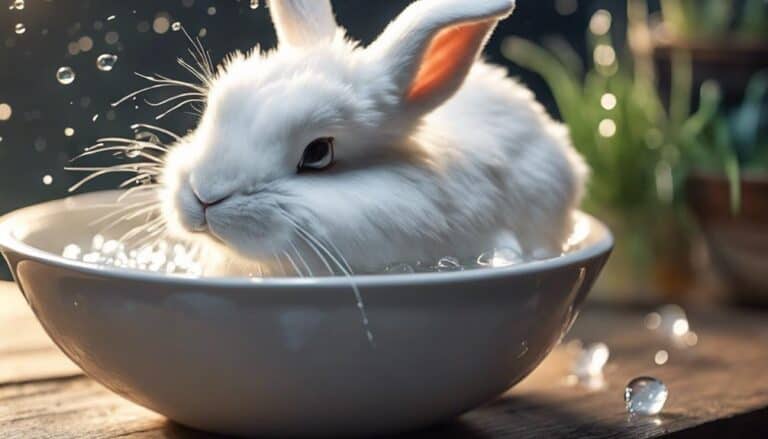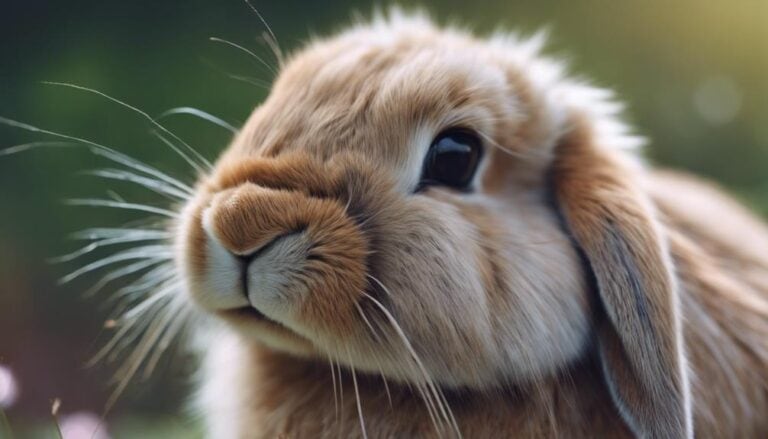So you’re wondering what sets tame rabbits apart from their wild cousins? The differences go way beyond just their looks. They also have distinct behaviors, lifespans, diets, and even ways of interacting with humans. Tame rabbits are often bred for sociability, making them more adept at forming bonds with humans and enjoying interactions, unlike their wild counterparts who tend to be more skittish. For those considering bringing a rabbit into their household, it’s important to choose suitable rabbit breeds for messy homes, as some breeds may be more prone to chewing and digging than others. Additionally, understanding their specific needs can lead to a happy and harmonious living environment for both the rabbit and its owner.
Understanding these differences can really show us how domestication has changed the nature of these furry friends. It's pretty amazing to see how much they can change when they go from living in the wild to living with humans.
For instance, did you know that tame rabbits can live up to 10-12 years, while wild rabbits typically live for only 2-3 years? That's a huge difference!
Their diets are also different. Tame rabbits eat commercial pellets and veggies, while wild rabbits munch on grasses, fruits, and veggies they find in their natural habitats.
Another big difference is how they interact with humans. Tame rabbits are socialized to be friendly and affectionate, while wild rabbits are naturally wary of humans and will avoid them if possible. This makes sense, given their different environments and lifestyles.
Contents
- 1 Key Takeaways
- 2 Lifespan Differences
- 3 Physical Characteristics Contrast
- 4 Sleep Patterns Variation
- 5 Activity Levels Disparity
- 6 Social Behavior Distinctions
- 7 Feeding Habits Divergence
- 8 Reproduction Variances
- 9 Predation Risk Discrepancies
- 10 Domestication Impact on Behavior
- 11 Human Interaction Effects
- 12 Conclusion
Key Takeaways
So, you're wondering what sets tame rabbits apart from their wild cousins? Well, let's start with the most obvious difference: their lifestyle. Tame rabbits are domesticated, which means they're bred to be our companions, whereas wild rabbits are non-domesticated and live in their natural habitats.
One of the most noticeable differences is their appearance. Tame rabbits come in a variety of colors and breeds, whereas wild rabbits have natural fur colors that help them blend in with their surroundings. For example, you might find wild rabbits with brown or grey coats that allow them to camouflage themselves.
Another difference is their physical characteristics. Tame rabbits tend to have shorter ears compared to their wild counterparts. They also come in a wider range of sizes. On the other hand, wild rabbits are generally more uniform in size.
Their behavior is also shaped by their environment. Tame rabbits have a consistent food supply, which means they don't need to forage for food like wild rabbits do. As a result, tame rabbits tend to be less active than their wild counterparts. Wild rabbits, on the other hand, have to work hard to find food and avoid predators, which makes them more active and vigilant.
Finally, tame rabbits are generally more sociable than wild rabbits. They're bred to form bonds with humans, so they tend to be more affectionate and interactive. Wild rabbits, by contrast, are more shy and focused on survival. They don't have the same level of trust in humans, and they're more likely to avoid them altogether.
Lifespan Differences
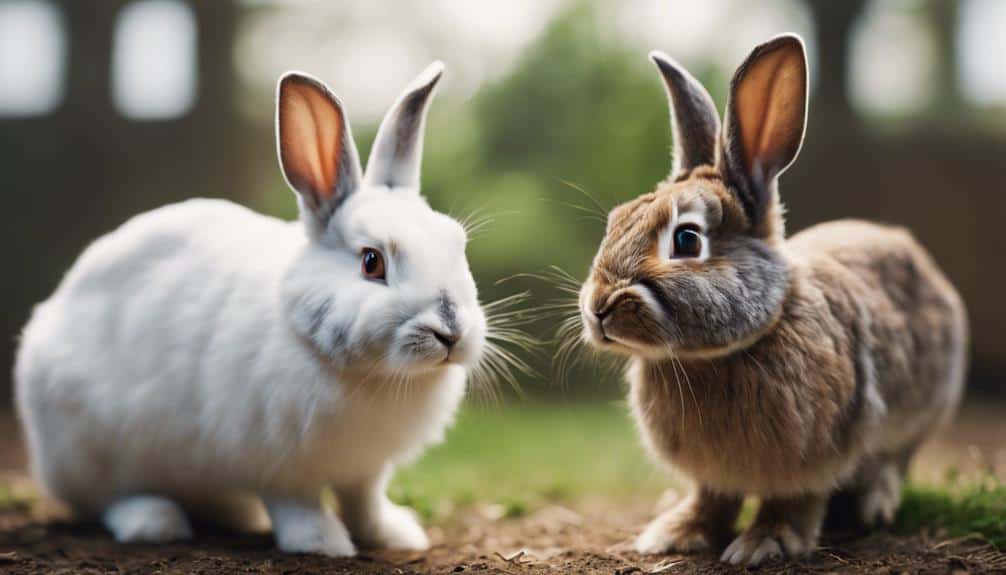
Domestic rabbits live a lot longer than wild rabbits, and it's mostly because of the way they're taken care of. With good care, a domestic rabbit can live for 8 to 12 years, and some might even make it past 12 years.
Wild rabbits, on the other hand, don't have it so good. They usually only live for about 1 to 2 years because they've to deal with predators and a tough environment.
The reason domestic rabbits live so much longer is that they've better living conditions. They get to eat a balanced diet, have clean water, and see a vet regularly. These things make a big difference in how long a rabbit lives.
Diet, health, and genetics are all important, and domestic rabbits have an advantage when it comes to these things.
The difference in care between domestic and wild rabbits adds up to a big difference in lifespan. In fact, domestic rabbits live about 5 to 6 times longer than wild rabbits.
This shows just how much of an impact humans can have on how long these animals live.
Physical Characteristics Contrast
Tame and wild rabbits are pretty easy to tell apart when it comes to their physical characteristics.
For one thing, their fur colors are different. Wild rabbits usually have colors that help them blend in with their surroundings, like brown or greenish tones. Tame rabbits, on the other hand, can come in a wide range of colors.
Another difference is their ears. Wild rabbits tend to have longer ears than tame rabbits.
And then there's the size and weight difference. Wild rabbits are often bigger and heavier than tame rabbits.
These physical differences are pretty noticeable, and they're a big part of what sets wild and tame rabbits apart.
Fur Color Variations
When you look at wild and domestic rabbits, one of the first things you notice is how different their fur colors are. And that's because these colors have helped them survive in their environments.
Domestic rabbits come in a wide range of colors – black, white, grey, brown, orange, and red. On the other hand, wild rabbits like the Eastern cottontail and European hare have fur that's speckled with brownish-red hues, which helps them blend in with their surroundings.
But what's really cool is that some wild rabbit species, like the Snowshoe hare, can even change the color of their fur with the seasons to stay camouflaged. You don't see this in domestic rabbits.
The reason wild rabbits need this kind of camouflage is to avoid predators. Domestic rabbits, on the other hand, don't need it because they're in controlled environments.
The different fur colors are really important for wild rabbits' survival strategies. And while domestic rabbits don't need camouflage, their many fur colors are part of what makes them so visually appealing – there are over 200 recognized breeds worldwide!
Ear Shape Differences
Wild rabbits and domestic rabbits have pretty distinct differences in their ear shapes, which is a pretty cool contrast in their physical characteristics.
One of the biggest differences is the size and shape of their ears. Wild rabbits usually have longer ears that stand more upright. These big ears are super helpful in the wild because they help the rabbits detect predators and potential threats from a distance.
Their excellent hearing allows them to stay on high alert and respond quickly to dangers in their natural habitat.
Domestic rabbits, on the other hand, often have shorter and more rounded ears compared to their wild cousins. Because humans have bred domestic rabbits, their ear shapes have changed over time.
Some breeds even have 'lop' ears that droop down. These changes in ear shape don't affect their hearing abilities that much, but they're largely a result of what humans have done through breeding.
Size and Weight
When we compare wild and domestic rabbits, one big difference we notice is their size and weight.
Wild rabbits usually weigh between 2-4 pounds. Domestic rabbits, on the other hand, can weigh anywhere from 2-12 pounds, depending on the breed. Some domestic breeds, like the Flemish Giant, can even get up to 22 pounds! That's huge compared to the smallest wild rabbit breed, the Pygmy Rabbit, which weighs around 1.3 pounds.
When it comes to length, domestic rabbits can grow up to 12 inches long. Wild rabbits, however, usually reach around 8-10 inches in length. But again, there are some domestic breeds that are super small, like the Netherland Dwarf, which can be as short as 6-8 inches. On the other hand, some breeds, like the Checkered Giant, can get up to 15 inches long.
One more thing that sets wild and domestic rabbits apart is their body shape. Wild rabbits tend to have longer ears and hind legs compared to their body size. Domestic rabbits, on the other hand, are usually more compact and stocky. These size and weight differences are some of the main ways we can tell domestic and wild rabbits apart.
Sleep Patterns Variation
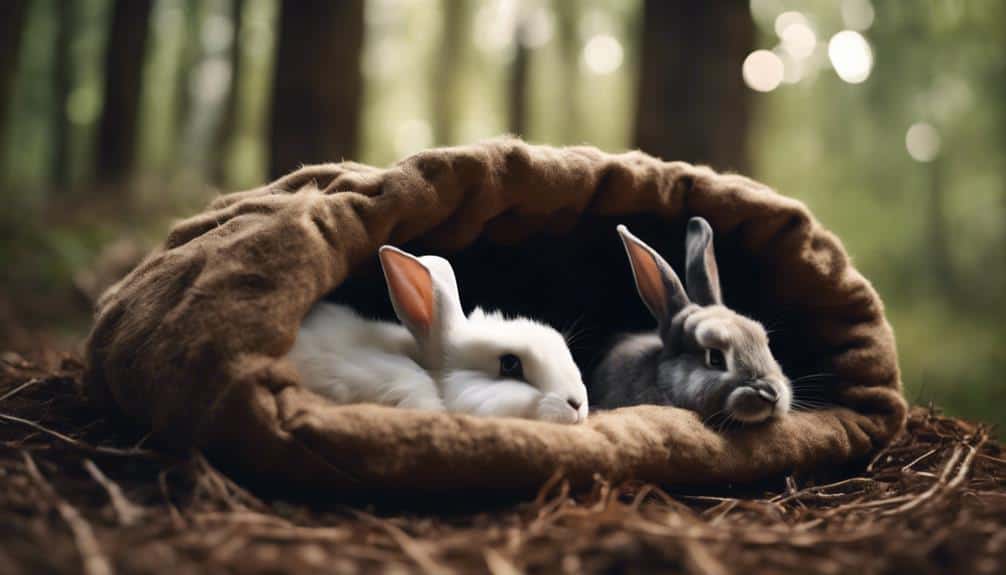
Wild rabbits have a pretty unpredictable sleep schedule. They take short naps during the day and night to stay on the lookout for predators. This makes sense, given their wild environment.
Domestic rabbits, on the other hand, tend to adjust their sleep patterns to match their human caregivers' schedules. They might sleep for longer periods, especially if they feel safe in their environment.
Understanding these differences in sleep behavior can offer some valuable insights. It shows how adaptable rabbits are to different environments and how they can thrive in both wild and domestic settings.
Domestic Rabbit Sleep Habits
Domestic rabbits are a bit different from their wild counterparts when it comes to sleep. By understanding their sleep habits, you can get a better sense of their overall well-being.
So, what's unique about domestic rabbits? For starters, they're crepuscular, meaning they're most active during dawn and dusk. This affects their sleep patterns in some interesting ways.
One key thing to know is that domestic rabbits love to take naps. They'll often doze off for short periods throughout the day, usually in a spot where they feel safe and secure.
Unlike their wild cousins, domestic rabbits don't need to be 'on the lookout' all the time. They thrive in peaceful environments, which means they can get more restful sleep.
Interestingly, domestic rabbits often sync up their sleep patterns with their human companions. They'll adjust their rest periods to coincide with times of low activity in the household. This is probably because they feel more comfortable and secure when their humans are around.
Wild Rabbit Sleep Behavior
Wild rabbits have a unique sleep pattern that's different from their domestic counterparts. During the day, they take short naps to rest while still being vigilant for potential threats in their environment. This is because they're crepuscular, meaning they're most active at dawn and dusk.
Unlike domestic rabbits, wild rabbits only sleep for around 4-6 hours a day. This is much less than domestic rabbits, who can sleep for up to 8.4 hours a day. The main reason for this difference is that wild rabbits need to be constantly on the lookout for predators in their natural habitat.
Here's a comparison table to highlight the differences between the sleep patterns of wild and domestic rabbits:
| Aspect | Wild Rabbits | Domestic Rabbits |
|---|---|---|
| Daily Sleep Hours | 4-6 hours | 8.4 hours |
| Sleep Type | Short bursts with frequent awakenings | Consistent and longer periods of sleep |
Wild rabbits have adapted their sleep behavior to their natural environment, where predators are a constant threat. By sleeping in short bursts and being able to quickly respond to danger, they increase their chances of survival in the wild.
Activity Levels Disparity
The difference in activity levels between tame and wild rabbits is mainly due to the way they adapt to their environment and behave. Wild rabbits, because they've to deal with predators and find their own food, tend to be more active than domestic rabbits.
Wild rabbits have evolved to be always on the move, searching for food sources and avoiding predators. They're constantly running, jumping, and digging to survive in the wild. This is just what they need to do to stay alive.
Domestic rabbits, on the other hand, often lead a more sedentary lifestyle. This is because their human caregivers provide them with a consistent supply of food and shelter. They don't have to worry about finding their next meal or escaping from predators, so they're generally less active.
As a result, domestic rabbits tend to be more relaxed and have lower activity levels. They don't have the same stressors as wild rabbits, so they don't need to be as active to survive.
Understanding these differences in activity levels can help rabbit owners provide the right environment and enrichment for their pets. This, in turn, ensures the well-being and happiness of their rabbits.
Social Behavior Distinctions
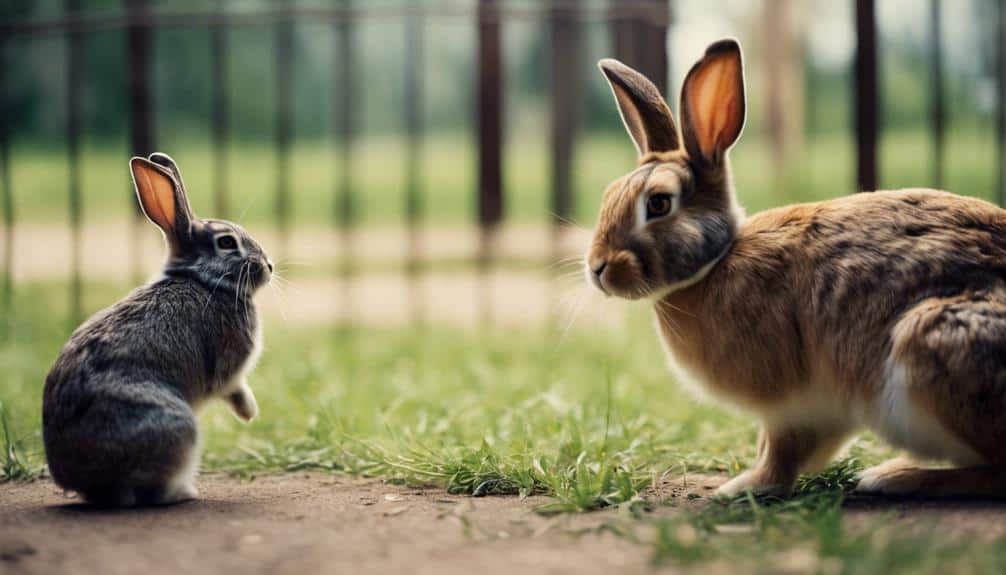
When we look at how rabbits behave socially, we can see some big differences between wild rabbits and tame ones. Wild rabbits tend to be shy and fearful because of their natural instincts and how they were raised. They live in big groups with complex social structures, like European rabbits, where being dominant and having territory is crucial.
On the other hand, domestic rabbits are capable of forming close bonds with humans and other rabbits, which makes them seem more sociable.
When it comes to social behavior, wild rabbits focus on building strong group dynamics to survive in their natural habitats. They use complex communication methods to navigate their communities. In contrast, domestic rabbits display social behaviors that are more adaptable to human interaction, allowing them to form close bonds with their caretakers and other domesticated rabbits.
Understanding these differences in social behavior helps us see how rabbits interact and communicate in their respective environments in unique ways.
Feeding Habits Divergence
Wild rabbits are total grazers. They love to munch on grasses and forage for wildflowers, clover, bark, and twigs to get the nutrients they need.
On the other hand, domestic rabbits have a very different diet. They mainly eat hay to stay healthy, and their owners also give them fresh veggies and pellets as part of their daily meals.
This difference in what they eat shows just how distinct their eating habits and foraging behaviors are, whether they're living in the wild or in a cozy home with a human family.
Dietary Preferences Comparison
When you compare the dietary preferences of tame and wild rabbits, it's clear that they've some big differences in their eating habits.
Wild rabbits mostly eat grass and other plants, whereas domestic rabbits rely heavily on hay – it makes up about 85-90% of their daily food intake.
Domestic rabbits, on the other hand, have a more varied diet that includes hay, pellets, and veggies. Wild rabbits, by contrast, mainly munch on clover, grass, wildflowers, bark, and crops from farms and gardens.
Wild rabbits also change their diet depending on the season. During the colder months, they'll eat buds, twigs, and conifer needles.
Domestic rabbits, though, don't need to adjust their diet to the seasons.
Domestic rabbits need a diet that's high in fiber and low in protein to stay healthy. Wild rabbits, however, have a more adaptable diet that lets them survive on whatever resources are available in their environment.
These differences in what tame and wild rabbits like to eat show how their eating habits have evolved to fit their unique lifestyles and environments.
Foraging Behavior Contrast
Foraging behavior in rabbits is really different between wild and domesticated individuals. This is because they've different dietary needs and have adapted to their environments in unique ways.
Wild rabbits are natural foragers. They mostly eat grass, wildflowers, and clover to blend in with their surroundings and avoid predators.
On the other hand, domestic rabbits rely heavily on hay, with some fresh vegetables and pellets added to their diet.
One major difference between the two is how their diets change with the seasons. Wild rabbits adapt their foraging habits to what's available during different times of the year. In the colder months, they eat bark, conifer needles, buds, and twigs.
Domestic rabbits, however, have a consistent diet that's managed by humans.
It's also worth noting that hay, a staple in domestic rabbit diets, isn't something wild rabbits would naturally eat. The way wild rabbits forage is instinctual, driven by the need to survive in the wild.
In contrast, domestic rabbits rely on their caretakers to provide a balanced diet.
This contrast in foraging behavior really highlights how environmental factors and human intervention can impact the dietary habits of rabbits.
Reproduction Variances
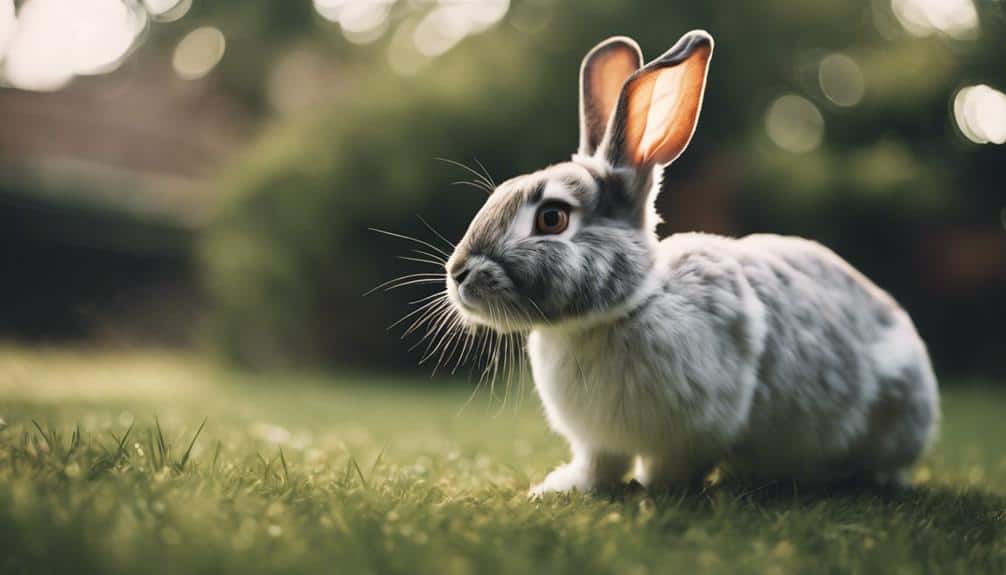
Reproduction patterns are quite different between domestic and wild rabbits, and it's mainly because of factors like breeding season length and litter size.
When we compare rabbits and wild rabbits, some key differences stand out. For one, wild rabbits typically breed from February to September, whereas domestic rabbits can breed year-round because we can control their environments.
Another difference is litter size. Wild rabbit females can have up to seven litters per year, with two to eight young per litter. Domestic rabbit females, on the other hand, typically have two to four litters per year with three to eight young per litter.
The gestation period for both wild and domestic rabbits is approximately 28-30 days. However, wild rabbits often have a shorter breeding season.
Domestic rabbits are often bred for specific traits, which results in a more limited gene pool. Wild rabbits, on the other hand, breed freely without human intervention, leading to a more diverse genetic makeup.
Understanding these differences in reproduction can provide insights into the distinct behaviors and adaptations of domestic and wild rabbits.
Predation Risk Discrepancies
Wild and domestic rabbits are worlds apart when it comes to their risk of being preyed upon. This difference has a huge impact on their behaviors and survival strategies.
In the wild, rabbits have a much higher risk of being killed by predators, which means they usually don't live more than 1-2 years. On the other hand, domestic rabbits can live for 10-12 years if they're well taken care of. This constant threat of predators has made wild rabbits extremely cautious, affecting their behavior, physiology, and survival tactics.
In contrast, domestic rabbits are more relaxed and less vigilant since they're protected from most predators by humans.
Wild rabbits have to be very careful to survive. They do this by being active at night, living alone, and constantly moving to avoid predators.
Domestic rabbits don't need to do these things because they're not in danger of being preyed upon.
The huge difference in predation risk between wild and domestic rabbits plays a big role in shaping their lifestyles, behaviors, and overall survival strategies.
Domestication Impact on Behavior
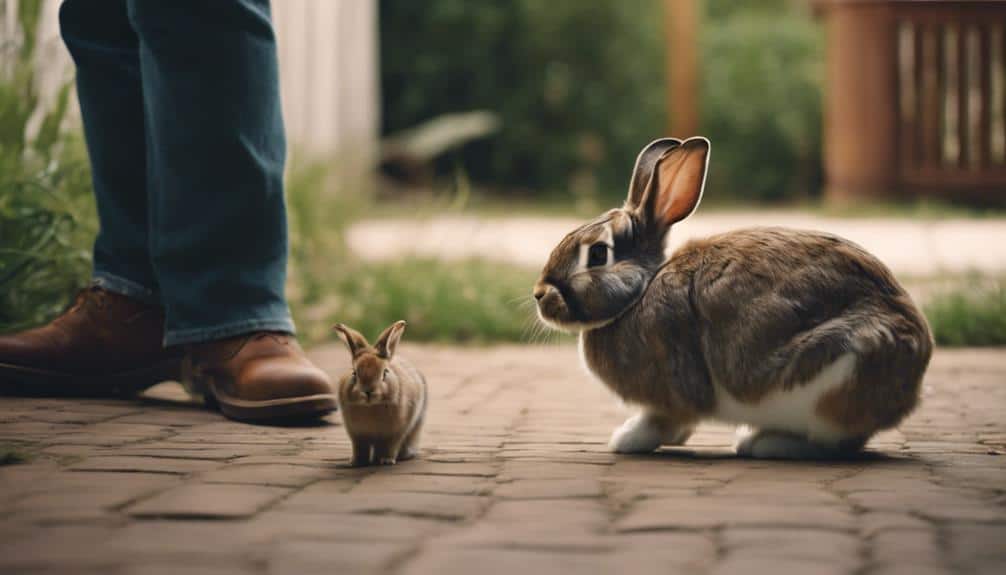
The process of domestication has had a profound impact on the behavior of rabbits, leading to some pretty significant differences between domestic and wild individuals.
When it comes to their social structure, domestic rabbits tend to be super sociable and tolerant of each other. They get along pretty well, whereas their wild counterparts are a bit more hierarchical and territorial. They're more likely to fight over resources and territory.
Wild rabbits are also way more fearful than their domestic counterparts. They've to be, since they're constantly dealing with predators in the wild. As a result, they've developed a strong flight response to stay safe. Domestic rabbits, on the other hand, don't have to worry about predators as much, so they're less fearful.
Domestication has also changed the way rabbits reproduce. In the wild, rabbits can be pretty aggressive during mating season. But domestic rabbits have been bred for docility, so they're less aggressive during mating. Plus, they're often bred in controlled environments, which can affect their reproductive behaviors.
Foraging behavior is another area where domestic and wild rabbits differ. Wild rabbits have developed all sorts of complex behaviors to find food in their natural habitats. They've to be clever to survive. Domestic rabbits, on the other hand, often have a consistent and controlled food supply, so they don't need to be as clever when it comes to finding food.
Understanding these behavioral differences between wild and domestic rabbits can give us some really valuable insights into how domestication affects the behavior of these amazing animals.
Human Interaction Effects
Human interaction has a huge impact on how domestic rabbits behave and respond compared to their wild counterparts. Since domestic rabbits rely entirely on humans for their basic needs like food and shelter, they've learned to not only tolerate but even enjoy human interaction.
Over time, through breeding and socialization, domestic rabbits have lost the fear response that wild rabbits have when they encounter humans.
Wild rabbits, on the other hand, have a strong instinct to either flee or defend themselves because they've evolved to avoid predators.
In contrast, domestic rabbits need to be socialized early on to become comfortable with human interaction, which helps them form strong bonds with their caretakers.
Wild rabbits, having had no exposure to human companionship, remain shy and fearful.
As a result, you can see the effects of human interaction in how domestic rabbits can reciprocate attention and affection, which is very different from the instinctual response of fear and avoidance that wild rabbits have when it comes to human contact.
Conclusion
So, what's the main difference between tame rabbits and wild rabbits?
Well, it's more than just how long they live, how they look, or how they behave.
Domestic rabbits have it pretty good – they live longer and more comfortably because they're taken care of by humans.
On the other hand, wild rabbits have to deal with all sorts of challenges in their natural environment.
This really shows how much humans can affect the way animals evolve and survive.
Next time you see a rabbit, remember that there's a big difference between living in a safe, cozy home and living in the wild.


